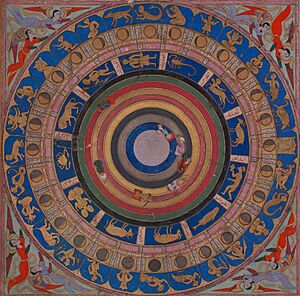Astrology in the medieval Islamic world facts for kids
Many medieval Muslims were very interested in studying astrology. They believed that stars and planets were important. Also, people traveling in deserts often moved at night. They used their knowledge of constellations (groups of stars) to find their way.
After Islam began, Muslims needed to know the exact times for prayers. They also needed to find the direction of the Kaaba (a holy building in Mecca) and how to face a mosque (a Muslim place of worship). All these needs encouraged the study of astronomy (the study of space). This also led to the idea that stars and planets could affect things on Earth and even people's lives. The study of these influences was called astrology (in Arabic, Ilm an-Nujūm). It was part of the bigger field of astronomy (Ilm al-Falak). These ideas came from old Arabian, Persian, Babylonian, Greek, and Indian traditions. Muslims developed these studies further after building a great observatory and library in Baghdad in the 700s.
During the medieval period, Muslim religious scholars and scientists often debated if astrology was truly useful. However, to make astrological predictions, people needed a lot of scientific knowledge. This need encouraged them to study and improve astronomy.
Contents
Early Discoveries in Islamic Astrology
Medieval Islamic astrology and astronomy continued ideas from old Greek and Roman times. These ideas were based on Ptolemy's famous book, the Almagest. Important learning centers for medicine and astronomy/astrology were set up in Baghdad and Damascus. The ruler Al-Mansur of Baghdad built a major observatory and library there. This made Baghdad a world center for studying the stars. During this time, knowledge about astronomy grew a lot. Many modern star names actually come from their Arabic names.
Key Thinkers and Their Contributions
Albumasur, also known as Abu Ma'shar (805 - 885), was a very important Islamic astrologer. In his book Introductorium in Astronomiam, he wrote that by watching how planets move, we can understand the many changes in the world. This book was one of the first to be translated into Latin. It traveled through Spain to Europe in the Middle Ages. It greatly helped bring back interest in astrology and astronomy there.
Persians also connected medicine and astrology. They linked the healing power of herbs to specific zodiac signs and planets. For example, the planet Mars was thought to be hot and dry. So, it was believed to rule plants with a hot or spicy taste, like hellebore, tobacco, or mustard. European herbalists like Culpeper used these ideas for a long time, until modern medicine developed.
Persians also created a system to calculate "parts." This involved finding the difference between the ascendant (a point in the sky) and each planet. This new position became a "part." For example, the "part of fortune" was found by adding the difference between the Sun and the ascendant to the Moon's position. If this "part" was in a certain place, it could suggest how someone might earn money.
Important Astronomers and Calendars
The calendar created by Omar Khayyam is based on the classical zodiac. This calendar is still used today in Afghanistan and Iran as the official Solar Hijri calendar.
Another important Persian astrologer and astronomer was Qutb al-Din al Shirazi (1236–1311). He wrote reviews of Ptolemy's Almagest. He also wrote two major books on astronomy: 'The Limit of Accomplishment Concerning Knowledge of the Heavens' (1281) and 'The Royal Present' (1284). Both books improved on Ptolemy's work, especially about how planets move.
Ulugh Beyg was a ruler from the Timurid family in the 1400s. He was also a mathematician and astronomer. He built an observatory in 1428. He then created the first new star map since Ptolemy's time. His map corrected the positions of many stars and added many new ones.
Medieval Debates About Astrology
Some medieval Islamic astronomers disagreed with parts of astrology. These included Al-Farabi, Ibn al-Haytham, Avicenna, Abu Rayhan al-Biruni, and Averroes. They had scientific reasons for their doubts. For example, they felt astrologers' methods were based on guesses, not facts. They also had religious reasons, as some astrological ideas conflicted with Islamic teachings.
However, their disagreements were mostly about judicial astrology (predicting specific events for people). They did not usually disagree with the idea that stars and planets could have some general influence on Earth. For example, Avicenna wrote a book against astrological predictions. But he still believed that each planet had some effect on Earth. His main point was that it was very hard for astrologers to know the exact effect. So, Avicenna didn't say astrology was completely wrong. He just said that humans couldn't fully understand all its precise effects.
Another scholar, Ibn Qayyim Al-Jawziyya (1292–1350), also used scientific arguments against astrology. He thought it was too much like divination (fortune-telling). He pointed out that stars are much bigger than planets. He argued:
And if you astrologers answer that it is precisely because of this distance and smallness that their influences are negligible, then why is it that you claim a great influence for the smallest heavenly body, Mercury? Why is it that you have given an influence to al-Ra's and al-Dhanab, which are two imaginary points [ascending and descending nodes]?
Al-Jawziyya also argued that the Milky Way is made of "a myriad of tiny stars packed together." He said it was "certainly impossible to have knowledge of their influences."
See Also
- Astronomy in the medieval Islamic world
- Christian views on astrology
- Hellenistic astrology
- Horary astrology
- Islam and astrology
- Jewish views on astrology
- List of astrologers
- Natal astrology
- Superstitions in Muslim societies


